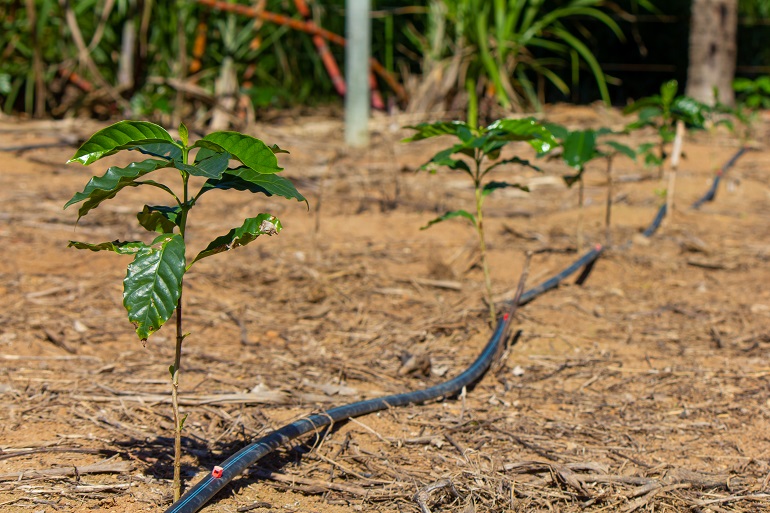From Rainwater Harvesting to Irrigation of Coffee Trees

This post is also available in:
This post is also available in:
![]() Français (French)
Français (French) ![]() العربية (Arabic)
العربية (Arabic) ![]() Português (Portuguese (Brazil))
Português (Portuguese (Brazil))
One of the most common questions I get has to do with how I irrigate my crop. In general, coffee requires a moderate amount of water to produce a high yield. While it is a fact that during the seedling stage, plants should be watered at least three times, when it comes to the actual plantation, things are handled differently. Traditionally, this crop has been grown by taking advantage of a natural water source: rain.
As mentioned in previous texts, the ideal precipitations for coffee growth and development must be between 1,000 to 3,000 millimeters per year.
This water accumulation might be evenly distributed or accumulated during one or more specific periods of the year. Take Guatemala, my home country, for example, which tends to have only two seasons, 6 months of summer and six months of rainy winter. Colombia, one of the most important coffee-producing countries, meets this precipitation requirement by having two annual rainy seasons, one from the end of March until the beginning of June and the second one goes from the end of September until the start of December. Both countries have their precipitation levels distributed differently. Nevertheless, for both, water is given by nature during the most critical developmental stages of the crop, after flowering, and when the grain consolidates.
Because of climate change and now irregular rainy seasons or because the vast demand for the bean has taken farmers to try and grow coffee in different terrains, countries like Vietnam, Ethiopia, and Brazil have turned to irrigation practices in their plantations. Now, that is not to say that artificial irrigation cannot be applied or does not happen already. As I previously mentioned, I grow my crop using an agroforest method which, when combined with the natural precipitation levels in my country, creates the perfect conditions to utilize the natural water cycle.
How much water does a coffee plant need?
How much water you will need will depend on the farm’sfarm’s climate, temperature, and soil. In Brazil, it has been reported that farms can consume about 94,000L of water per hectare per week, whilst new water management programs in Vietnam have economized the traditional use of 1000 liters per tree per irrigation round by taking it down to 400L.
Without a doubt, irrigation methods have advantages like improving the quantity and quality of the crop, but it also allows farmers to plant Coffee in lands with irregular pluvial precipitations. However, this does not necessarily mean that you must turn to it, and before trying it, you should consider the following:
- Access to water. Are there any water sources around you, such as rivers, lakes, ponds, or wells?
- Installation costs. Here you should consider the system you will need and define the prices of the hoses, tubes (and the length), drip emitters, and sprinklers (including the amount you will need).
- Soil. The type of soil, its drainage capacity, and water retention capability will be key in determining how much water you require. Here is where the samples and analysis that you have previously taken come in handy.
- Topography. What are the particularities of your terrain? Is your water source below your plantation? Then you will need a water pump. Is the angle of the ground slope wider than 45°? That might make it difficult not only to install the system but you will need to plan a strategy to avoid runoff water. Consider all factors that will improve your water efficiency.
- Irrigation timing. Do it in the early morning, afternoon, or early night. Doing it when the sun is at its best may cause the water to create a magnifying glass effect and damage the foliar. Depending on your location, research when it is best to irrigate according to the flowering cycles and ensure irrigation, is done as evenly as possible. Not knowing and doing this might lead to irregular fruit ripening.
The cons do not necessarily outperform the pros or vice-versa. In my case, for example, the conditions of my land do not require the use of irrigation. Even though combining it with a fertigation system might increase my productivity, the unsteady prices in the coffee industry have not made it viable for me to invest in one of these methods. However, as a farmer, I cannot always use the philosophy of not fixing something until it breaks. There are constant threats like the increase of extended dry seasons, mean temperatures (high and low), low minimum temperatures, and annual precipitation (high and low) because of climate change, so as a farmer, I need to plan for a worst-case scenario.
Irrigation practices in coffee plantations have shown an improvement in the photosynthesis process and increased production quantity and bean quality. Finca Rabanales, in the outskirts of Guatemala City, has reported that their experimental lot of about 0.70 ha (0.3 acres) has increased, going from producing an average of 6,802.50 kg (14997 lbs) in berry bean to an average of 13,605.00 kg (29994 lbs) (Roughly 80 sacks of processed coffee) while Brazilian farms have reported results varying between 60 to 150 sacks depending on factors such as region, coffee variety and plant’s age.
Irrigation Systems
Drip irrigation: It supplies water to plants at very low but constant rates. It is efficient as it prevents water losses due to evaporation or runoff. A water supply line with a series of drip emitters that are placed at the base of each plant. This guarantees that water will go directly to the plants. This same method can be combined with Fertigation practices.
Rain gun or impact sprinkler irrigation: It uses a high-pressure pump to force water through a large sprinkler head, which is mounted on a moving arm. The arm rotates, and as it does, it sprays water out of the sprinkler head in a circular pattern. I find this method to be effective in coffee nurseries. However, in actual plantations with fully grown trees, it might not be as effective if they are not well calibrated, as there could be water loss through evaporation, runoff, or overspray.
Rain hose kits irrigation: it is also known as “soaker hose.” This system is placed near the base of the plants, and water is fed through the hose via a faucet or a timer-operated valve. As with the drip system, water goes directly to the roots.
Manual irrigation: as the name might suggest, this method requires manual labor, and it is more time-consuming. The most common way to apply this system is by using a high-pressure hose to manually water the tree. This method has been applied in Vietnam’s central highlands and India. It is mostly applied to Robusta plantations.
References
Revista Visão Agrícola, Escola Superior de Agricultura “Luiz de Queiroz”, 2013, Marcos Vinícius Folegatti e André Luís Teixeira Fernandes* Fórum Editorial: https://www.esalq.usp.br/visaoagricola/sites/default/files/va12-conducao-da-lavoura04.pdf
Revista Visão Agrícola, Escola Superior de Agricultura “Luiz de Queiroz”, 2013, André Luís Teixeira Fernandes e Luiz Antonio Lima https://www.esalq.usp.br/visaoagricola/sites/default/files/va12-conducao-da-lavoura03.pdf
Globo Rural Brazil, news report 01/05/2017 https://globorural.globo.com/Noticias/Videos/noticia/2017/05/saiba-qual-o-volume-necessario-de-agua-para-irrigar-15-mil-pes-de-cafe.html
Determination of Optimal Irrigation Scheduling for Coffee (Coffee Arabica L.) at Gera, South West of Ethiopia, International Journal of Research Studies in Agricultural Sciences (IJRSAS), Volume 7, 2021 https://www.arcjournals.org/pdfs/ijrsas/v7-i1/5.pdf
Café Irrigado Apresenta Bons Resultados, UNESP, Departamento de Fitossanidade, Engeharia Rural e Solos, Brazil. 2000. P.6 http://www2.feis.unesp.br/irrigacao/cafe_irrigado.htm
- Fenicafé Brazil, https://fenicafe.com.br/noticias/na-fenicafe-netafim-apresenta-tecnologias-e-solucoes-para-irrigacao-tecnificada
- https://www.thereporterethiopia.com/25957/
- https://www.kerchanshe.com/water-source-and-irrigation
- https://www.esalq.usp.br/visaoagricola/sites/default/files/va12-conducao-da-lavoura04.pdf
- https://www.hrnstiftung.org/water-management-vietnam/
- https://ecofriendlycoffee.org/the-fine-art-of-irrigation-in-robusta-coffee-plantations/
Coffee plant History and general Information
Coffee Plant Information – Morphology
Coffee Genetics and Variety Selection
How to Select, and Treat Coffee Seeds
Germination of Coffee Seeds and Creation of Seedbeds for Planting
Coffee Trees Planting and Plant Spacing
How to Prune your Coffee Trees in an Agroforestry System
Shade-Grown Coffee in an Agroforestry System
Coffee Tree Flowering and Pollination
From Rainwater Harvesting to Irrigation of Coffee Trees
Coffee Tree Fertilization Requirements
Weed Management in a Coffee Plantation








































































